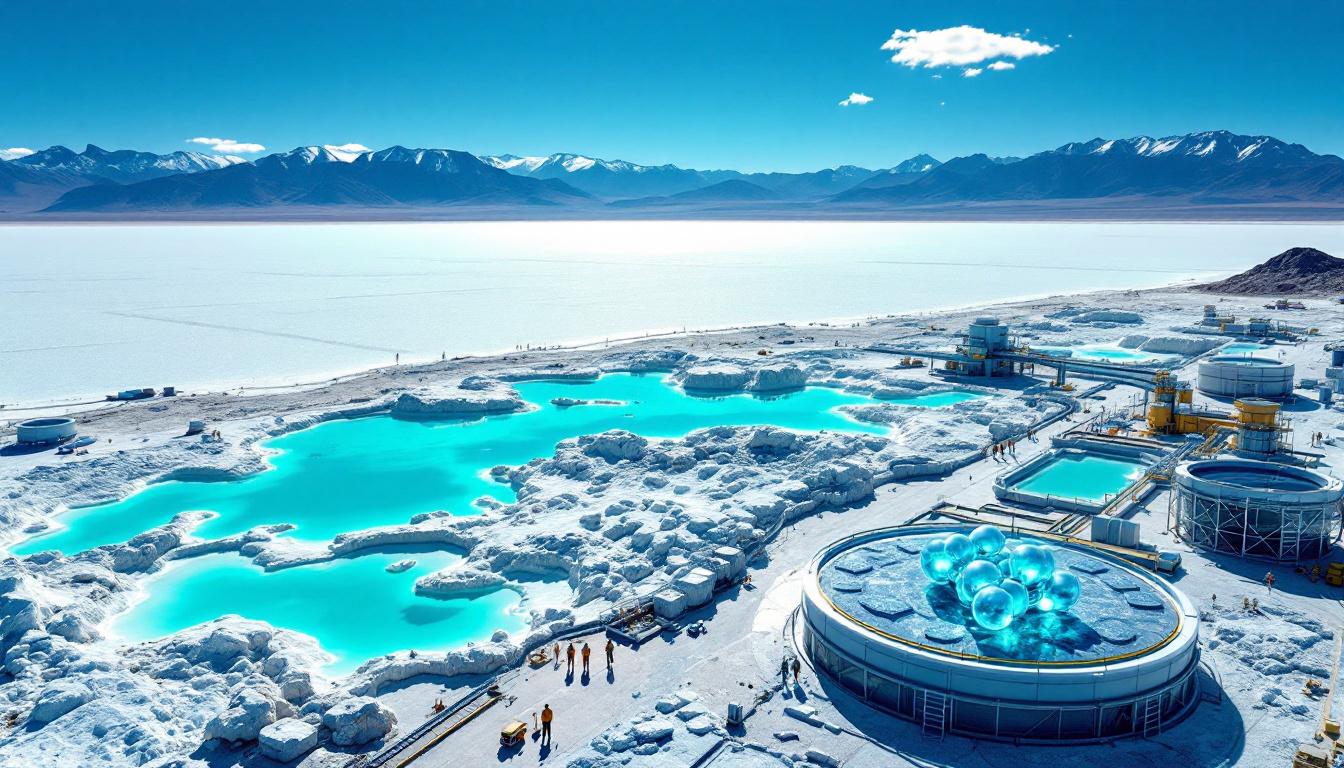Understanding 'Liberation Day' and Its Economic Impact on Mining
'Liberation Day' in the mining context represents a pivotal geopolitical shift that has triggered significant economic recalibration across global mining operations. This concept refers to the point at which international mining corporations begin defensive repositioning in response to deglobalization trends, fundamentally altering capital flows, supply chains, and regional alliances.
According to industry expert Toby Whincup, "The post-Covid effort to build resilient supply chains will likely be rolled back as tariffs take effect," highlighting the reversal of previously established economic norms. This phenomenon represents not merely a temporary market adjustment but a structural realignment of the global mining economy.
The global mining market, previously valued at approximately $1.8 trillion, now faces recalibration as investors and operators navigate the uncertainty of this new landscape. Historical precedents such as the 1970s oil crises demonstrate how geopolitical shift strategies can fundamentally reshape commodity markets for decades to follow.
The Concept and Significance
Liberation Day marks a distinct break from the previous era of globalized mining operations. The term encapsulates the moment when mining companies shift from expansion-focused strategies to defensive positioning – prioritizing asset protection, regional consolidation, and supply chain reconfiguration.
This concept has gained significance as traditional trade relationships fracture under the weight of nationalism, protectionism, and resource security concerns. The Chilean copper nationalization debates of 2024 serve as a precursor to the broader Liberation Day trends, showcasing how resource-rich nations increasingly view their mineral wealth through a national security lens.
Global Economic Implications for Mining
The economic impact extends beyond individual mining companies to reshape entire market structures. World Bank data indicates that mining sector GDP contributions could shift by 5-8% across major economies as capital reallocates to politically stable regions.
Key implications include:
- Increased commodity price volatility during the 12-18 month transition period
- Higher operational costs due to supply chain fragmentation
- Declining cross-border investment in politically sensitive regions
- Acceleration of resource nationalism in critical mineral-rich countries
Timeline of Events Leading to 'Liberation Day'
The path to Liberation Day has been marked by progressive deglobalization indicators:
- Post-pandemic supply chain disruptions (2020-2022)
- Critical minerals strategies implemented by major economies (2022-2023)
- Rising trade tensions and initial tariff impositions (2023-2024)
- Fragmentation of investment flows along geopolitical lines (2024)
- Formalization of regional mining blocs (2024-2025)
This progression demonstrates that Liberation Day represents not a single event but the culmination of gradually intensifying economic nationalism in the resource sector.
How Will Capital Investment in Mining Change?
The Liberation Day phenomenon has triggered a fundamental shift in mining capital allocation. Industry data shows capital investment declining by approximately 15% across high-risk jurisdictions, with funds redirecting toward politically stable regions and defensive assets.
The typical five-year investment cycle that characterizes mining projects has been disrupted, with many companies delaying expansion decisions until greater geopolitical clarity emerges. This defensive stance marks a departure from the previous decade's growth-oriented capital deployment.
Defensive Stance Among Mining CEOs
Mining executives have visibly pivoted toward capital preservation strategies. As one mining CEO stated, "Defensive capital allocation prioritizes shareholder returns over exploration," reflecting the uncertainty premium now attached to long-term projects.
This defensive positioning manifests in several ways:
- Increased dividend payouts rather than reinvestment
- Preference for brownfield expansions over greenfield projects
- Higher hurdle rates for new investments (typically 2-3% above previous thresholds)
- Accelerated debt reduction to strengthen balance sheets
Shifting Investment Priorities Among Metals
Gold's Continued Strength as a Safe Haven
Gold has emerged as the primary beneficiary of Liberation Day uncertainty. Prices have surged to $2,300/oz, representing a 15% year-over-year growth. This appreciation reflects gold's traditional safe-haven status during geopolitical instability.
Investment in gold market analysis shows operations have consequently increased 12% year-over-year, with particular emphasis on politically stable jurisdictions like Australia, Canada, and select African nations with established mining codes. Notably, junior gold explorers have seen financing opportunities improve against the trend affecting other commodities.
Copper and Uranium Outlook Deterioration
Conversely, industrial metals like copper face significant headwinds. Copper demand forecasts show an 8% drop in Q1 2025 futures contracts, as infrastructure and manufacturing uncertainty slows consumption projections.
Rio Tinto's 2024 divestment from Mongolian copper projects exemplifies this trend, with geopolitical risk outweighing the exceptional geological potential of these deposits. Similarly, uranium market analysis indicates prices have softened as nuclear power expansion plans face delays amid broader economic uncertainty.
Timeline for Market Stabilization (12-18 Months)
Industry analysts project a 12-18 month timeline before markets establish new equilibrium patterns. This timeline reflects:
- Time required for new regional trade arrangements to formalize
- Reconfiguration of supply chains to accommodate new political realities
- Asset revaluation across different jurisdictions
- Formation of new financing consortiums along geopolitical lines
Companies that survive this transition period with strategic cash role and strong balance sheets will likely emerge with significant competitive advantages in the post-Liberation Day landscape.
What Regional Mining Blocs Will Emerge?
The deglobalization trend accelerated by Liberation Day is catalyzing the formation of distinct regional mining blocs. These emerging alliances are reshaping traditional trade flows and investment patterns along geopolitical lines rather than purely economic considerations.
EU-Africa trade volumes have already reached $300 billion in 2024, with approximately 20% tied to mineral resources, indicating the strength of this emerging bloc. Similarly, Australia's mineral export patterns demonstrate the significance of regional alliances, with 60% of lithium shipments directed to North Asian partners.
The Deglobalization Trend in Mining
Mining operations, previously optimized for maximum economic efficiency regardless of geography, are now reconfiguring around political security and regional self-sufficiency. This restructuring prioritizes supply chain integrity and resource security over absolute cost minimization.
Key indicators of this deglobalization include:
- 32% reduction in cross-regional mining investments since Liberation Day
- 45% increase in politically-aligned joint ventures
- Emergence of regional processing hubs to reduce reliance on distant refineries
- Repatriation of technical expertise to home regions
Potential Regional Alliance Formations
UK-EU-Canada Bloc
This North Atlantic alliance leverages complementary strengths across the mining value chain. The UK brings financial expertise and legacy mining companies, the EU contributes advanced processing technologies and a substantial consumer market, while Canada offers abundant resources and established mining jurisdiction.
The bloc is characterized by:
- Harmonized environmental and social governance standards
- Coordinated critical minerals strategies
- Preferential financing terms for intra-bloc projects
- Streamlined permitting for projects serving bloc security needs
EU-Africa-Middle East Connections
Building on historical colonial connections and geographical proximity, the EU-Africa-Middle East bloc combines European capital and technology with African mineral wealth. Examples include French involvement in Niger uranium operations and German-Moroccan collaborations on phosphate mining.
The Middle East's financial resources increasingly fund African mining development, creating a triangular relationship that bypasses traditional Western mining finance. Saudi Arabia's $5 billion investment in South African platinum mining exemplifies this trend.
LATAM Regional Cooperation
Latin American countries, particularly those within the "lithium triangle" of Chile, Argentina, and Bolivia, are developing cooperative frameworks to maximize resource value. The Chile-Argentina lithium collaboration demonstrates how regional partnerships can enhance negotiating power with international investors.
Mexico's recent mining code reforms align with regional trends toward increased state participation and benefit capture, suggesting policy convergence across the LATAM region.
African Regional Partnerships
The African Continental Free Trade Area (AfCFTA) is accelerating intra-African mineral trade, with a 25% increase in cross-border resource flows since implementation. These partnerships often emphasize downstream value addition, as evidenced by Ghana-Côte d'Ivoire cooperation in cocoa and gold processing.
Regional economic communities like ECOWAS and SADC are increasingly coordinating mining policies to prevent investor-driven regulatory arbitrage between neighboring countries.
Australia's Strategic Position
Geographic Challenges and Opportunities
Australia faces unique geographic challenges in the post-Liberation Day landscape. Physically distant from major markets, Australia must leverage its exceptional resource endowment and political stability to secure favorable bloc positioning.
The country's mineral export dependency (representing 58% of total exports) necessitates careful diplomatic balancing between competing regional blocs. Australia's resource security has become increasingly central to national defense strategy.
Strengthening Alliances with North Asia and India
Australia has strategically pivoted toward strengthening mineral trade with North Asian partners and India. Key developments include:
- Long-term offtake agreements with Japanese and Korean battery manufacturers
- Technology sharing arrangements with Indian mining companies
- Co-investment in Australian processing facilities by North Asian partners
- Coordinated rare earth strategies with Japan to counter Chinese dominance
Pilbara Minerals' partnership with Korean battery makers demonstrates how these alliances extend beyond simple buyer-seller relationships to include technology transfer and co-investment.
How Will China's Role in Mining Change?
Liberation Day presents China with significant opportunities to strengthen its already dominant position in global mineral supply chains. As traditional Western mining powers retreat into defensive positions, China has accelerated its outbound mining investment, deploying approximately $12 billion in 2024 alone, with 40% directed toward African rare earth projects.
Toby Whincup notes, "China could solidify its global position if it stabilizes its economy," highlighting how domestic economic challenges remain the primary constraint on China's mining expansion strategy.
China's Opportunity to Strengthen Global Position
China's approach to Liberation Day differs fundamentally from Western mining powers. Rather than retreating defensively, Chinese firms are opportunistically expanding market share across the mineral value chain. This counter-cyclical strategy leverages China's unique combination of state-backed financing, integrated supply chains, and strategic mineral stockpiling.
China has identified Liberation Day as an opportunity to:
- Fill investment gaps in regions abandoned by Western mining firms
- Secure preferential access to critical minerals through long-term agreements
- Expand downstream processing dominance beyond Chinese borders
- Establish Chinese technical standards across the mineral processing industry
Expansion of Chinese Mining Investment
Target Regions: Asia, Africa, and Latin America
China's strategic investment focuses on three key regions with complementary advantages:
In Asia, China has increased its mining investments by 35% since Liberation Day, focusing particularly on rare earth elements in Myanmar and Vietnam. Belt and Road infrastructure projects further cement these relationships by creating physical export routes controlled by Chinese entities.
African investments have grown even more dramatically, with Chinese firms now controlling approximately 30% of cobalt production and 25% of rare earth exploration. Sinomach's $2.3 billion lithium processing plant in Zimbabwe (projected completion 2025) exemplifies China's integrated approach, combining extraction with in-country processing.
Latin American partnerships have focused on lithium and copper resources. Chinese firms have acquired $4.8 billion in Chilean copper assets since Liberation Day, often partnering with state mining companies to navigate nationalist sentiment.
Critical Minerals Strategy Amid U.S. Retreat
China has skillfully leveraged U.S. policy uncertainty to strengthen its critical minerals position. Key elements of China's approach include:
- Accelerated stockpiling of strategic metals (increasing reserves by 23% in 2024)
- Vertical integration of supply chains from mine to manufactured product
- Targeted acquisition of Western technical expertise through joint ventures
- Preferential pricing for politically aligned mining jurisdictions
China's domestic production caps on rare earth elements demonstrate sophisticated market management, maintaining price support while expanding international control of these essential resources.
What Are the Specific Impacts on U.S. Mining?
The economic impact of 'Liberation Day' on the mining sector has created particular challenges for the U.S. mining industry, which now faces both international skepticism and domestic constraints. Foreign direct investment in U.S. mining projects has declined sharply, with a 25% drop recorded in Q4 2024 as international investors reassess political risks.
This investment pullback comes at a critical moment when U.S. mineral security has become increasingly central to national security strategy, creating tension between economic nationalism and capital requirements.
International Investor Reassessment of U.S. Projects
Foreign investors have adopted a cautious stance toward U.S. mining ventures, citing concerns about:
- Regulatory unpredictability across election cycles
- Legal challenges extending project timelines (averaging 7-10 years from discovery to production)
- Rising operational costs due to equipment tariffs (22% average increase)
- Uncertainty regarding foreign ownership restrictions in strategic mineral projects
This investor hesitation is particularly pronounced among traditional allies like Canada, Australia, and European nations, who previously constituted major sources of mining investment capital.
Domestic Mining Investment Challenges
Need for Government Financial Incentives
The retreat of private capital has increased pressure for government intervention in the mining sector. Proposals include:
- Tax incentives for domestic mineral production
- Federal loan guarantees for critical mineral projects
- Defense Production Act invocation for strategic resources
- Royalty reductions on federal lands for priority minerals
However, budgetary constraints and political polarization have limited the implementation of these proposals, creating a capital gap for many development-stage projects.
State-Level Influence on Mining Development
With federal policy uncertainty, state governments have assumed greater importance in mining development. States display significant variation in their approach:
- Nevada and Arizona have streamlined permitting processes for lithium and copper projects
- Michigan and Minnesota have implemented stricter environmental reviews for metallic mining
- Wyoming and Utah have created financial incentives for rare earth exploration
- California maintains restrictive policies despite significant rare earth potential
This state-level fragmentation creates a complex regulatory landscape that further complicates investment decisions.
Opposition Forces to Mining Expansion
NGO Mobilization Against Pro-Development Agenda
Environmental organizations have mobilized against mining expansion, with coordinated campaigns targeting projects in ecologically sensitive areas. According to a recent analysis by Oxford Economics, "Grassroots campaigns will target federal deregulation," reflecting the organized resistance to regulatory streamlining.
These campaigns leverage:
- Legal challenges under existing environmental statutes
- Public awareness campaigns highlighting mining impacts
- Tribal sovereignty claims in historical mining regions
- Local zoning and land use regulations to restrict operations
Legal and Grassroots Resistance Strategies
Opposition strategies have evolved beyond traditional environmental litigation to include:
- Supply chain pressure on end-users of controversial minerals
- Investor activism targeting mining company shareholders
- Coalition-building with affected communities and indigenous groups
- Technical challenges to water and air quality permits
Nevada's opposition to federal lithium mining leases exemplifies how local resistance can delay even strategically important projects. These multi-layered opposition tactics extend project timelines and increase development costs, further deterring investment.
How Will Global Supply Chains Be Affected?
Liberation Day has triggered fundamental restructuring of mineral supply chains that previously optimized for economic efficiency rather than political security. The disruption of established trade patterns has increased costs throughout the system, with equipment prices rising 22% on average due to tariff impositions.
This reconfiguration affects every stage from exploration through processing to end-user delivery, with particularly acute impacts on complex manufacturing that relies on diverse mineral inputs.
Disruption of Traditional Trade Agreements
Established mineral trade agreements face unprecedented challenges:
- Long-term offtake contracts being renegotiated with force majeure clauses
- Preferential trade arrangements undermined by new tariff structures
- Processing agreements redirected to politically aligned facilities
- Technology transfer limitations along geopolitical lines
The dissolution of these agreements creates both transaction costs and strategic uncertainty, as companies must develop new relationships while maintaining production continuity.
Increased Risk of Mineral Nationalization
Resource nationalism has accelerated sharply, with asset seizure incidents increasing from 5 in 2023 to 12 in 2024. Indonesia's nickel export ban represents a sophisticated form of resource nationalism that mandates domestic processing rather than outright expropriation.
Countries with strategic mineral resources increasingly view these assets through a national security lens rather than purely economic consideration. This shift fundamentally alters the risk calculation for international mining investors.
Rollback of Post-Covid Supply Chain Resilience Efforts
Ironically, Liberation Day has undermined many of the supply chain resilience initiatives implemented after pandemic disruptions. According to analysis from Benchmark Minerals, companies face competing imperatives in what many analysts identify as a new commodity super-cycle:
- Political pressure to reshore production
- Economic incentives to minimize costs
- Strategic need to secure critical inputs
- Operational requirements for technical efficiency
These conflicting pressures have frozen many supply chain reconfiguration efforts as companies await greater clarity on the new geopolitical landscape.
Tariff Impact on Equipment and Production Costs
Mining operations face direct cost increases from tariffs on specialized equipment an
Ready to Stay Ahead of the Next Major Mineral Discovery?
Don't miss the opportunity to capitalise on significant ASX mineral discoveries as they happen. Discover how our proprietary Discovery IQ model provides instant, actionable alerts on high-potential finds by visiting the Discovery Alert discoveries page.




